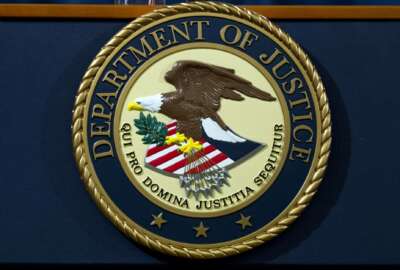
Deregulating for an easier pandemic response
CDC, FDA, even the Centers for Medicare and Medicaid Services have all trimmed, relaxed or altered regulations.
Best listening experience is on Chrome, Firefox or Safari. Subscribe to Federal Drive’s daily audio interviews on Apple Podcasts or PodcastOne.
The coronavirus has marched through parts of the federal regulatory apparatus like a boll weevil through a cotton field. CDC, FDA, even the Centers for Medicare and Medicaid Services have all trimmed, relaxed or altered regulations. For a summary, Federal Drive with Tom Temin spoke with the senior research fellow at the Center for Growth and Opportunity, Will Rinehart. You can find the report here: https://www.growthopportunity.org/archives/2020/chart-2020.001.pdf
Interview transcript:
Tom Temin: Mr. Rinehart, good to have you on.
Will Rinehart: Yeah. Thanks so much Tom. Thanks for having me on and talking about these issues.
Tom Temin: Now you have tracked some of the changes, basically, of CDC and the FDA. And this has been going back and forth. Now this relaxation of rules and procedures, almost to the beginning of the year. Give us a quick summary.
Will Rinehart: Yeah. So I think a lot of what we’re trying to understand now, or at least what I’m trying to understand now is what exactly happened with these regulatory agencies, especially, you know, in the kind of the critical moments and the critical moments for me really start somewhere around February 10, and effectively end February 29, when there was a whole bunch of relaxation of different rules. But the idea with this larger project, and really what I’m trying to understand is really what happened, what were the actual rules that seemed to have made a really big difference in this crisis that seemed to have expanded testing? And there really are a couple I think key moments that occurred, particularly under, you know, February 10 is a big one for me, but also February 29, when there was a pretty large expansion of testing and kind of an opening up of the regulatory structure.
Tom Temin: Alright, let’s start with February 10. First, because we don’t get very many February 29.
Will Rinehart: Yes. So February 10, I think is really a critical moment, at least as I see it. This is when when the FDA is made aware that the CDC testing is really is pretty poor, and that they’re having troubles in their own testing. So by at least, going back a month, it seems that the CDC had testing and could do COVID testing, and they were among the first it seems. And it seems that they also ran their first test around January 18. About a week later, the CDC then says, hey we’re working on these set of tests and we’re going to get them all, we’re going to get them to the public labs pretty quickly. And then about a week after that, about a week and a half or so after that beginning of February, the CDC starts shipping all of these testing kits, but pretty quickly they then realize, or at least the public labs start realizing, that they’re having these faulty problems as we now know. So around February 10 is when the FDA realizes or at least is made aware that that there are problems with the CDC testing. Now they don’t then open up testing to the larger public laboratory and clinicians groups and kind of the larger public until the 29th. When they start relaxing rules and start, I don’t want to say relaxing rules because they’re not as they’re still pretty stringent rules, it’s just a lot of the a lot of the hoops that that some companies would have to go through in order to actually get their tests approved are kind of rationalized in a much more real sense. So this February 29 date, I think is pretty critical because this is when New York, public health labs are able to test. And then this is also when the University of Washington’s virology lab started enabling tests and these labs are doing really high quality work. It’s just that we, I think we can now recognize that what the FDA required of these of these labs is, it was pretty onerous at the time, sometimes it was it was sending in, for example, a hard bound copy of their application into the FDA instead of doing everything online. And, you know, there’s just a whole there’s a whole range of things that were required by by these labs that really should have been dealt with much much earlier.
Tom Temin: So in other words in relatively good speed for something like the FDA, 19 days, they did find brush work that they could clear out and get things maybe?
Will Rinehart: Yes very much, though, in a quick changing public health crisis, there is this larger question of why it did take them, you know, all of this time. So by at least the 10th they should have recognized there was a clear problem with their supply chain. And that’s, I think, to me, that’s probably the most critical moment which you would, or at least naturally, I would start looking for other suppliers. If you’re working with one single supplier, which they were in the CDC to provide all these tests, I personally would then start looking okay who else is doing this kind of work? Where are they in the process? I think that those were critical moments, because obviously, that’s when the virus seems to have spread pretty dramatically in New York and in Washington. And to me, that’s really the the time period at which you would want to start looking for other sources of testing. And you’d also want to start considering, you know, public and private options that that are probably occurring at that time as well.
Tom Temin: Stepping back from all of this detail in the back and forth between the two agencies and what they were trying to accomplish. What’s the bigger picture here in terms of the right level of regulation, or how fast and how flexible federal agencies perhaps should be when confronted with a really dire situation?
Will Rinehart: So I think, in part what I’ve found in this research and in talking with people and and, you know, compiling a lot of the different reports that exist out there is that in some regards, these agencies really don’t deserve as much blame people are heeping upon them right now. You know, they’re actually in many instances shifting quite quickly, and they’re quite responsive. But at the same time, I think that there was not a real wide recognition even throughout February that the COVID virus was going to be as as expansive in the United States as it now clearly is. So a lot of people didn’t recognize that this would be the source of a major pandemic. And, you know, that’s really I don’t think that people are to blame for the fact that they didn’t recognize it. This is going to be such a big Issue, you know, MERS and SARS didn’t come to the United States in a way that it came to other other countries. And in fact, United States, even at the end of last year was rated among, you know, rated as having among the best pandemic response teams in the world. So, in many regards, I don’t think that the agencies themselves deserve as much blame, it’s difficult to create these tests, it’s difficult to create high quality testing and get them approved through the FDA process. So in part, I don’t necessarily blame them for some of the problems that have occurred. But at the same time I also do think that that there really should be in the future, in the near future, at least, we’re going to have to look back at this and figure out exactly what went wrong and at what time periods and I’m hoping to at least kind of start thinking through that. I think that right now we really do need to recognize that yeah, there were some critical time periods where we did make mistakes and that you know, especially with local health care practitioners, let’s not make those sorts of mistakes, you need to be testing as wide as possible. And you need to start tracking people. And you need to try to figure out where exactly the sources are and start trying to contain those sources.
Tom Temin: And do you expect that perhaps some of the regulatory excesses that were in place may not ever come back such as you know, sending in a CD ROM or a memory stick of something you’ve already emailed?
Will Rinehart: Yeah, exactly. Yeah, I think some of that stuff will probably go the way of the dodo. I would hope that we do in the future, we’re a little bit more fast acting when it comes to these sorts of responses. There’s other things that will clearly occur in the near future once this crisis is finished. So I haven’t mentioned this entire,what’s called an emergency use authorization process. So once the Secretary of Health and Human Services declares a public state of emergency, there’s this new process that’s put into place and that actually really kind of complicates things for local hospitals trying to respond to the virus. So there is actually a series of reforms that are being talked about for diagnostic testing at this current point, which is probably something that will occur because diagnostic testing is in this kind of weird regulatory space, the FDA claims regulatory authority over diagnostic testing. But at the same time, Congress clearly did not give the FDA clear authority over diagnostic testing. And so that type of regulatory confusion which actually seems to have contributed to, to a slowdown, especially in the University of Washington, and some other Washington public health agencies, that regulatory confusion probably will be dealt with. There’s a what’s called a Valid Act currently in Congress right now trying to deal with this problem. But very honestly, I think that the diagnostic diagnostic testing, regulation will probably get cleared up, if nothing else, and we’ll probably have a different sort of regime to deal with pandemic responses in the future. Now, it doesn’t necessarily help us obviously right now because we’re in kind of a Somewhat dire situation. But in the future, I do believe we’ll be much, much better able to respond to these. And again, I think that overall, we’ve had some bad fumbles and some missteps. But by the same token, I don’t necessarily think that the agencies are completely to blame for all of this.
Tom Temin: And now, the Center for Medicare and Medicaid Services has also relaxed a whole bunch of rules, you have to really know the Medicare language and it is a language that is only partially resembling English, but they’ve also relaxed a lot of rules and regulations. Will you be looking into those also?
Will Rinehart: Yes, that’s actually the next big area that I’m trying to dive into. I’ve got a really long look at the, you know, the CDC and FDA regulatory processes, but the next thing I think that we’re going to have to really consider are tax related issues. As you mentioned, CMS, a lot of this has to come down to billing so questions about billing actually seem to have popped up a number of times early in the conversation especially in in Washington state. So the the question about taxing I’ve talked to a couple of my friends who work in in this tax space and they have said, yeah, the taxes and what’s happening, what has happened with CMS has actually been another big area of potential reform and that’s really probably also where we need to spend some time and trying to clear things as well. But again, I want to highlight the fact that, you know, there has been actually a pretty solid positive response, at least at the local level to a lot of these problems. It’s just that this virus really does overwhelm all, you know, it does really overwhelm all local capacity. And that really is just something that you know, you can try to plan for, but in some ways, it’s really just a unique event that we have to deal with.
Tom Temin: Will Rinehart is Senior Research Fellow with the Center for Growth and Opportunity at Utah State University. Thanks so much for joining me.
Will Rinehart: Thanks for having me.
Tom Temin: We’ll post this interview along with a link to the deregulatory timeline at federalnewsnetwork.com/federal drive. Here the federal drive on demand and on your devices, subscribe at Apple podcasts or podcast one
Copyright © 2025 Federal News Network. All rights reserved. This website is not intended for users located within the European Economic Area.
Tom Temin is host of the Federal Drive and has been providing insight on federal technology and management issues for more than 30 years.
Follow @tteminWFED





